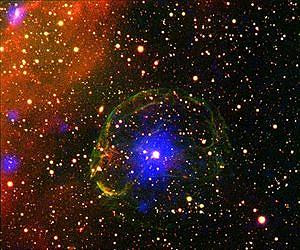The X-ray pulsar SXP 1062 embedded in the remnant of the supernova that created it. Credit: ESA/XMM-Newton/ L.Oskinova/ M.Guerrero; CTIO/R.Gruendl/Y.H.Chu.
Astronomers have discovered a very slowly rotating X-ray pulsar still embedded in the remnant of the supernova that created it.
This unusual object was detected on the outskirts of the Small Magellanic Cloud, a satellite galaxy of the Milky Way, using data from a number of telescopes, including ESA's XMM-Newton.
A puzzling mismatch between the fairly young age of the supernova remnant and the slow rotation of the pulsar, which would normally indicate a much older object, raises interesting questions about the origin and evolution of pulsars.
The spectacular supernova explosion that marks the end of a massive star's life also has an intriguing aftermath.
On the one hand, the explosion sweeps up the surrounding interstellar material creating a supernova remnant that is often characterised by a distinctive bubble-like shape, on the other hand, the explosion also leaves behind a compact object - a neutron star or a black hole.
Since supernova remnants shine only for a few tens of thousands of years before dispersing into the interstellar medium, not many compact objects have been detected while still enclosed in their expanding shell.
An international team of astronomers has now discovered one of these rarely observed pairs, consisting of a strongly magnetised, rotating neutron star - a pulsar - surrounded by the remains of the explosion that generated it.
The newly found pulsar, named SXP 1062, is located at the outskirts of the Small Magellanic Cloud (SMC), one of the satellite galaxies of the Milky Way. SXP 1062 is an X-ray pulsar, part of a binary system in which the compact object is accreting mass from a companion star, resulting in the emission of copious amounts of X-rays.
The astronomers first detected the pulsar's X-ray emission using data from ESA's XMM-Newton as well as NASA's Chandra space-based observatories. A later study of optical images of the source and its surroundings revealed the bubble-shaped signature of the supernova remnant around the binary system.
"The most interesting aspect of this pulsar is possibly its extremely long period - 1062 seconds - which makes it one of the slowest pulsars on record," comments Lidia Oskinova from the Institute for Physics and Astronomy in Potsdam, Germany, coordinator of the team that analysed the X-ray data.
Pulsars rotate quite rapidly in their early stages, with periods of only a fraction of a second, and then slow down gradually with age. "Slowly spinning pulsars are particularly difficult to detect. Only a few with periods longer than a thousand seconds have been observed to date," she adds.
Astronomers have discovered a very slowly rotating X-ray pulsar still embedded in the remnant of the supernova that created it.
This unusual object was detected on the outskirts of the Small Magellanic Cloud, a satellite galaxy of the Milky Way, using data from a number of telescopes, including ESA's XMM-Newton.
A puzzling mismatch between the fairly young age of the supernova remnant and the slow rotation of the pulsar, which would normally indicate a much older object, raises interesting questions about the origin and evolution of pulsars.
The spectacular supernova explosion that marks the end of a massive star's life also has an intriguing aftermath.
On the one hand, the explosion sweeps up the surrounding interstellar material creating a supernova remnant that is often characterised by a distinctive bubble-like shape, on the other hand, the explosion also leaves behind a compact object - a neutron star or a black hole.
Since supernova remnants shine only for a few tens of thousands of years before dispersing into the interstellar medium, not many compact objects have been detected while still enclosed in their expanding shell.
An international team of astronomers has now discovered one of these rarely observed pairs, consisting of a strongly magnetised, rotating neutron star - a pulsar - surrounded by the remains of the explosion that generated it.
The newly found pulsar, named SXP 1062, is located at the outskirts of the Small Magellanic Cloud (SMC), one of the satellite galaxies of the Milky Way. SXP 1062 is an X-ray pulsar, part of a binary system in which the compact object is accreting mass from a companion star, resulting in the emission of copious amounts of X-rays.
The astronomers first detected the pulsar's X-ray emission using data from ESA's XMM-Newton as well as NASA's Chandra space-based observatories. A later study of optical images of the source and its surroundings revealed the bubble-shaped signature of the supernova remnant around the binary system.
"The most interesting aspect of this pulsar is possibly its extremely long period - 1062 seconds - which makes it one of the slowest pulsars on record," comments Lidia Oskinova from the Institute for Physics and Astronomy in Potsdam, Germany, coordinator of the team that analysed the X-ray data.
Pulsars rotate quite rapidly in their early stages, with periods of only a fraction of a second, and then slow down gradually with age. "Slowly spinning pulsars are particularly difficult to detect. Only a few with periods longer than a thousand seconds have been observed to date," she adds.







No comments:
Post a Comment